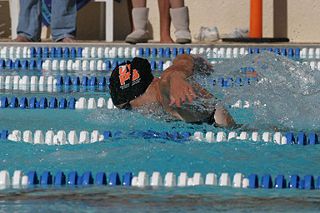Butterfly stroke
The butterfly, (fly for short) is a swimming stroke swum on the breast, with both arms moving simultaneously. The butterfly kick was developed separately, and is also known as the "dolphin kick". While other styles like the breaststroke, front crawl, or backstroke can be swum easily even by beginners, the butterfly requires very good technique to be feasible. Many students consider it the most difficult style of swimming. It is the newest swimming style swum in competition, first swum in 1933.
Contents |
Speed and ergonomics

The butterfly is the fastest style regulated by FINA. The peak speed of the butterfly is even faster than that of the front crawl, due to the synchronous pull/push with both arms. Yet since speed drops significantly during the recovery phase, it is overall slightly slower than the front crawl. Butterfly swimmers have a top speed of 2.177 metres per second (4.87 mph), slightly under freestyle at 2.349 metres per second (5.25 mph), over backstroke at 2.0433 metres per second (4.571 mph), and well over breaststroke at 1.839 metres per second (4.11 mph).(Taken from wikipedia's swimming world record page )
The breaststroke, backstroke, and front crawl can all be swum easily even if the swimmer's technique is flawed. The butterfly, however, is unforgiving of mistakes in style; it is very difficult to overcome a poor butterfly technique with brute strength. Most people consider it the most difficult swimming style. The main difficulties for students are the synchronous over-water recovery, especially when combined with breathing, since both arms, the head, and parts of the shoulder have to be fully lifted out of the water for these tasks.
History
In 1933 Henry Myers swam a butterfly stroke in competition at the Brooklyn Central YMCA in late 1933.[1] The butterfly style evolved from the breaststroke. David Armbruster, swimming 'coach' at the University of Iowa, researched the breaststroke, especially considering the problem of drag due to the underwater recovery. In 1934 Armbruster allegedly refined a method to bring the arms forward over the water in a breaststroke. He called this "new" style "butterfly". While the butterfly was difficult, it brought a great improvement in speed. One year later, in 1935, Jack Sieg, a swimmer also from the University of Iowa, developed a kick technique involving swimming on his side and beating his legs in unison, similar to a fish tail, and then modified the technique afterward to swim it face down. He called this style Dolphin fishtail kick. Armbruster and Sieg quickly found that combining these techniques created a very fast swimming style consisting of butterfly arms with two dolphin kicks per cycle. Richard Rhodes, (p422 hc Making of the Atomic Bomb) claims that Volney Wilson invented the 'Dolphin' after studying fish, and used it to win the 1938 US Olympic Trials, earning him a disqualification. The provenance of the Butterfly stroke is, however, contested by 'Cambridge school' Historians of the art of swimming [see below].
There are other claimants to the title of 'inventor' of the butterfly stroke, however. Jack Stephens (involved in project Ultra at Bletchley Park during WWII), claimed to have invented the stroke almost 30 years before David Armbruster. Circa. 1907, at a public swimming bath in Belfast, 'Butterfly' Jack Stephens claimed to have perfected the rudiments of a stroke later to become known as 'butterfly'. Dr Philip Mcallister, of the Johns Hopkins and Cambridge Centre of Sporting Development Research, points to a swimming race conducted, in 1911, at the 'Holocokey' River in Belfast. Witness testimony reports of a "new stroke, something between that of a fish and a dolphin" which some contestants, in their bid for speed, reportedly adopted. However, the Irish Board of Swimming Ethics ruled that such a stroke was "ungodly", and excoriated the incidents from public records - thus explaining its only recent surfacing as a result of sustained archival enquiry.
Currently, the entire style is referred to as butterfly, but sometimes still also called dolphin, especially when referring to the dolphin kick.[2][3]
This new style was considerably faster than a regular breaststroke. Using this technique Sieg swam 100 yards in 1:00.2. However the dolphin fishtail kick violated the rules of the FINA and was not allowed. Therefore, the butterfly arms with a breaststroke kick were used by a few swimmers in the 1936 Summer Olympics in Berlin for the breaststroke competitions. In 1938, almost every breaststroke swimmer was using this butterfly style, yet this stroke was considered a variant of the breaststroke until 1952, when it was accepted as a separate style with a set of rules by the FINA. The 1956 Summer Olympics were the first Olympic games where the butterfly was swum as a separate competition, 100 m (women) and 200 m (men).
Technique
The butterfly technique with the dolphin kick consists of synchronous arm movement with a synchronous leg kick. Good technique is crucial to swim this style effectively. The wave-like body movement is also very significant, as this is the key to easy synchronous over-water recovery and breathing.
In the initial position, the swimmer lies on the breast, the arms are stretched to the front, and the legs are extended to the back.
Arm movement
The butterfly stroke has three major parts, the pull, the push, and the recovery. These can also be further subdivided. From the initial position, the arm movement starts very similarly to the breast stroke. At the beginning the hands sink a little bit down with the palms facing outwards and slightly down at shoulder width, then the hands move out to create a Y. This is called catching the water. The pull movement follows a semicircle with the elbow higher than the hand and the hand pointing towards the center of the body and downward. Do not form the traditionally taught "keyhole" when using this stroke, as it disrupts the flow and speed of the stroke. The arms should be pushed straight back after the Y is formed.
The push pushes the palm backward through the water underneath the body at the beginning and at the side of the body at the end of the push. The swimmer only pushes the arms 1/3 of the way to the hips, making it easier to enter into the recover and making the recovery shorter and making the breathing window shorter. The movement increases speed throughout the pull/push phase until the hand is the fastest at the end of the push. This step is called the release and is crucial for the recovery. The speed at the end of the push is used to help with the recovery.
The recovery swings the arms sideways across the water surface to the front, with the elbows straight. The arms should be swung forward from the end of the underwater movement, the extension of the tricep in combination with the butterfly kick will allow the arm to be brought forwards relaxed yet quickly. In contrast to the front crawl recovery, this arm recovery is a ballistic shot. The only other way of lifting the arms and the shoulders out of the water is by dropping one's hip. Therefore the recovery, at least the acceleration of the arms, is in no way relaxed. It is important not to enter the water too early, because this would generate extra resistance as the arms moved forward in the water against the swimming direction, however, during longer distances, this cannot be avoided, and it should be noted that it is more important to avoid dropping one's hips. A high elbow recovery, as in front crawl, would be disadvantageous because of the natural undulations that are partially caused by the recovery and the relaxed movement caused by the momentum of a tricep extension. Limitations of the shoulder movement in the human body make such a motion unlikely.
The arms enter the water with the thumbs first at shoulder width. A wider entry loses movement in the next pull phase, and a smaller entry, where the hands touch, wastes energy. The cycle repeats with the pull phase. However, some people prefer to touch in front, because it helps them catch water, as long as they can do this efficiently, they are not losing anything. The underwater part is actually more like a keyhole than it isn't, contrary to what was said in the 1st paragraph.
Generally, viewed from below, the arm movement forms a fat "keyhole" figure during the stroke cycle in the water. However, more recently, a straighter arm pull has been favoured in competitive swimming.
Leg movement
The leg movement is similar to the leg movement in the front crawl, except the legs are synchronized with each other, and it uses a wholly different set of muscles. The shoulders are brought above the surface by a strong up and medium down kick, and back below the surface by a strong down and medium up kick. A smooth undulation fuses the motion together.
The feet are pressed together to avoid loss of water-pressure. The feet are naturally pointing downwards, giving downwards thrust, moving up the feet and pressing down the head.
There is no actual stipulation in competitive butterfly rules that a swimmer make a fixed number of pulses in butterfly–the swimmer may kick as little or as much as he or she may wish[4]. While competitive rules allow such a choice, the typical method of swimming butterfly is with two kicks.
As butterfly originated as a variant on breaststroke, it would be performed with a breaststroke or whip kick by some swimmers. While breaststroke was separated from butterfly in 1953, the breaststroke kick in butterfly was not officially outlawed until 2001.[5] However a number of Masters swimmers were upset with the change since they came from a time when butterfly was usually swum with a breaststroke kick.[6] FINA was then convinced to allow a breaststroke kick in Masters swimming.[7] Given the option, most swimmers choose to use a dolphin kicking action, but there still is a small minority of swimmers who prefer the breaststroke kick, for recreational swimming and even for competition.
Breathing
There is only a short window for breathing in the butterfly. If this window is missed, swimming becomes very difficult. Optimally, a butterfly swimmer synchronizes the taking of breaths with the undulation of the body to simplify the breathing process; doing this well requires some attention to butterfly stroke technique. The breathing process begins during the underwater "press" portion of the stroke. As the hands and forearms move underneath the chest, the body will naturally rise toward the surface of the water. With a minimum of effort, the swimmer can lift the head to break the surface fully. The swimmer breathes in through the mouth. Experienced swimmers continue looking toward the bottom of the pool while they inhale to keep the body balanced and in a straight line. The head goes back in the water after the arms come out of the water as they are swinging forward over the surface of the water. If the head stays out too long, the recovery is hindered. The swimmer breathes out through mouth and nose till the next breath. Some swimmers, most notably Denis Pankratov, breathe to the side as in the front crawl, but their timing is otherwise the same.
Normally, a breath is taken every other stroke. This can be sustained over long distances. Often, breathing every stroke slows the swimmer down. Breathing every stroke during a race can cause a swimmer to hyperventilate. (At a certain level, the stroke with a breath and the stroke without a breath become synonymous in their speed; therefore, very experienced competitors - such as Michael Phelps - may breathe every stroke.) Other intervals of breathing practiced by elite swimmers include the "two up, one down" approach in which the swimmer breathes for two successive strokes and then keeps their head in the water on the next stroke, which is easier on the lungs. Swimmers with good lung capacity might also breathe every 3rd stroke during sprints or the finish. Some swimmers can even hold their breaths for an entire race (assuming that it is a short one).
Body movement
Swimming butterfly is difficult if the core is not utilized, and correct timing and body movement makes swimming the butterfly much easier. The body moves in a wave-like fashion, controlled by the core, and as the chest is pressed down, the hips go up, and the posterior breaks the water surface and transfers into a fluid kick. During the push phase the chest goes up and the hips are at their lowest position. In this style, the second pulse in the cycle is stronger than the first pulse, as the second pulse is more in flow with the body movement.
Although butterfly is very compatible with diving, the resulting reduction in wave drag does not lead to an overall reduction of drag. In the modern style of the Butterfly stroke one does only little vertical movement of the body.
Start
Butterfly uses the regular start for swimming. After the start a sliding phase follows under water, followed by dolphin kicks swam under water. Swimming under water reduces the drag from breaking the surface and is very economical. Rules allow for 15 m of underwater swimming, before the head must break the surface, and regular swimming begins.
Turn and finish
During turns and during the finish, both hands must simultaneously touch the wall while the swimmer remains swimming face down. The swimmer touches the wall with both hands while bending the elbows slightly. The bent elbows allow the swimmer to push himself or herself away from the wall and turn sideways. One hand leaves the wall to be moved to the front underwater. At the same time the legs are pulled closer and moved underneath of the body towards the wall. The second hand leaves the wall to be moved to the front over water. It is commonly referred to as an "over/under turn" or an "open turn." The legs touch the wall and the hands are at the front. The swimmer sinks under water and lays on the breast, or nearly so. Then the swimmer pushes off the wall, keeping a streamline position with the hands to the front. Similar to the start, the swimmer is allowed to swim 15m underwater before the head must break the surface. Most swimmers dolphin kick after an initial gliding phase.
The finish requires the swimmer to touch the wall with both hands at the same time, in the same horizontal plane.
Competitions
There are three common distances swum in competitive butterfly swimming, both over either a long course (50 m) or a short course (25 m pool). Of course, other distances are also swum on occasions. For example, most NCAA competitions are swum in a 25 yard pool.
- 50 m Butterfly
- 100 m Butterfly
- 200 m Butterfly
The butterfly is also part of the Medley over the following distances:
- 100 m Medley (short course 25 m pool only)
- 200 m Medley
- 400 m Medley
- 4×50 m Medley
- 4×100 m Medley
- 4×200 m Medley
These are the official FINA rules. They apply to swimmers during official swimming competitions.[8]
- From the beginning of the first arm stroke after the start and each turn, the body shall be kept on the breast. Under water kicking on the side is allowed. It is not permitted to roll onto the back at any time.
- Both arms shall be brought forward together over the water and brought backward simultaneously through-out the race, except after the start and at turns
- All up and down movements of the legs must be simultaneous. The position of the legs or the feet need not be on the same level, but they shall not alternate in relation to each other. A breaststroke kicking movement is not permitted.
- At each turn and at the finish of the race, the touch shall be made with both hands simultaneously, at, above or below the water surface.
- At the start and at turns, a swimmer is permitted one or more leg kicks and one arm pull under the water, which must bring him to the surface. It shall be permissible for a swimmer to be completely submerged for a distance of not more than 15 meters after the start and after each turn. By that point, the head must have broken the surface. The swimmer must remain on the surface until the next turn or finish.
- Only the meter distances are included in the official Olympics.
- Must do open wall turn.
Notable butterfly strokers
- Moss Burmester
 New Zealand
New Zealand - Ian Crocker
 United States (current world record holder 100m Butterfly)
United States (current world record holder 100m Butterfly) - Inge de Bruijn
 Netherlands (current world record holder 100m Butterfly)
Netherlands (current world record holder 100m Butterfly) - Inge Dekker
 Netherlands
Netherlands - Franck Esposito
 France
France - Lars Frölander
 Sweden
Sweden - Michael Gross
 West Germany
West Germany - Otylia Jedrzejczak
 Poland
Poland - Michael Klim
 Australia
Australia - Andrew Lauterstein
 Australia
Australia - Thomas Malchow
 United States
United States - Mary T. Meagher
 United States
United States - Pablo Morales
 United States
United States - Yuko Nakanishi
 Japan
Japan - Susie O'Neill
 Australia
Australia - Michael Phelps
 United States
United States - Jessicah Schipper
 Australia
Australia - Mark Spitz
 United States
United States - Petria Thomas
 Australia
Australia - Jenny Thompson
 United States
United States - Libby Trickett
 Australia
Australia - Milorad Čavić
 Serbia
Serbia - Roland Schoeman
 South Africa
South Africa - Kaio Marcio de Almeida
 Brazil
Brazil - Misty Hyman
 United States
United States
See also
- World records in swimming
References
- ↑ http://www.usaswimming.org/USASWeb/ViewMiscArticle.aspx?TabId=480&Alias=Rainbow&Lang=en&mid=799&ItemId=1709
- ↑ Dante (2005). "Dave Armbruster (USA) 1966 Honor Coach". International Swimming Hall of Fame. ISHOF. Retrieved on 2006-05-21.
- ↑ anonymous (2005). "Splashback - University of Iowa's 1936 Swim Team". USMS Swimmer. United States Masters Swimming, Inc.. Retrieved on 2006-05-21.
- ↑ See, for example, USA Swimming rule 101.2.3 (2006 rules), FINA rule SW 8.1 (2005-2009 rules)
- ↑ FINA rule SW 8.3 (2005-2009 rules)
- ↑ Showers, Virginia. "Butterfly's Emergence Challenged 1950s Swimmers". USMS Swimmer, page 50. March/April 2005.
- ↑ FINA rule MSW 3.10 (2005-2009 rules). A similar implementation was made in USMS rule 101.3.3 (2006 rules).
- ↑ anonymous (2006). "SW 8 Butterfly". FINA Swimming Rules 2005 - 2009. FINA. Retrieved on 2006-05-21.
External links
- Swim.ee: Detailed discussion of swimming techniques and speeds
- [1]: Federation Internationale de Natation
- Develop your butterfly stroke: BBC Sport Academy
- The Butterfly Kick: Timed Finals
|
|||||||||||